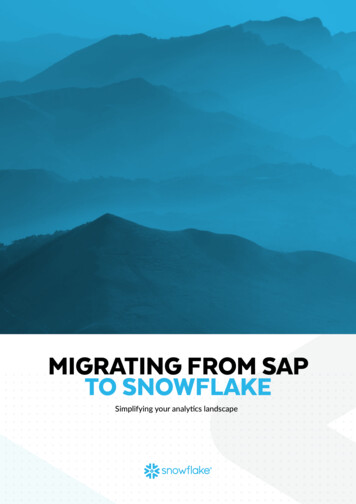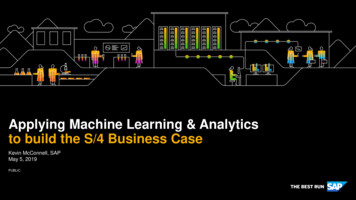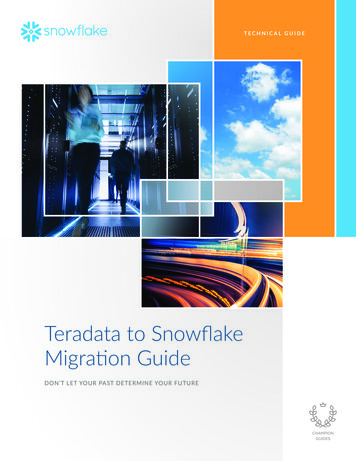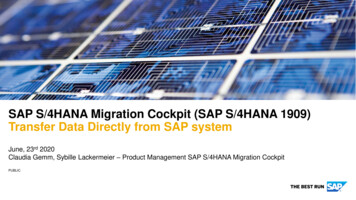
Transcription
MIGRATING FROM SAPTO SNOWFLAKESimplifying your analytics landscape
4Problems with SAP-to-Cloud Migration: Complexity and Rigidity5The Benefits of Offloading SAP Data into Snowflake6Workload #1: Replicate SAP BW Data into Snowflake8Workload #2: Replace SAP BW8Workload #3: Replace SAP HANA Data Warehouse9Workload #4: Keep SAP Business Objects and SAP Analytics Cloud,but Replace the Underlying Source9Snowflake Adds Value to SAP Cloud MigrationNET ZERO DATA2
EXECUTIVE SUMMARYSAP products are ubiquitous—77% of theworld’s transactions revenue touches anSAP system at some point, according toSAP.1 But 77% of the world’s data is not in anSAP system and it shouldn’t be. This paperexplains why. As organizations increasinglytransition critical transactional workloads tocloud-based iterations (often staying withSAP ERP or moving to SAP S/4HANA), SAPcustomers must, however, take pause andconsider replacing their legacy SAP analyticinfrastructure—SAP BW and SAP HANA datawarehouse. This is because S/4HANA takesback the operational reporting making anSAP-centric warehouse such as SAP BusinessWarehouse (BW) and HANA obsolete.The value of a data warehouse is adding nonSAP, semi-structured data to a customer’sSAP data. SAP cannot do this easily, if at all.Also, the migration of SAP analytics to thecloud often proves complex and rigid in termsof SAP’s non-native cloud data architectureand provides no additional value. Snowflakecan eliminate these stumbling blocks byproviding a platform for SAP customers that issimple, elastic, secure, and cost-effective.MIGRATING FROM SAP TONETSNOWFLAKEZERO DATA3
PROBLEMS WITH SAPTO-CLOUD MIGRATION:COMPLEXITY AND RIGIDITYCloud migration helps customers reduce costs,outsource asset management, and alleviate in-houseworkload burdens. But according to TechRepublic,as SAP customers migrate to the cloud, a great manyof them are having specific trouble with regard totheir data.2Many existing SAP customers are reviewingthe formal move to a hosted, cloud-based SAPS/4HANA suite. But there has been a great deal ofhesitation surrounding shifting on-premises SAPBW systems to SAP BW/4HANA because the latterwill not deliver the modern computational elasticity,variety, and compute that cloud-native solutionsprovide. Most companies also have data outside ofSAP, so there is no inherent advantage to keepingan on-premises or hosted SAP-centric BW system.SAP’s cloud answer—SAP Data Warehouse Cloud(SAP DWC)—is fractured. It does not have thematurity of SAP BW, and SAP’s approach of usingSAP DWC in combination with products such asSAP BW, SAP HANA Cloud, and SAP Hana DataLake increases the complexity of the landscaperather than reducing it. Is there any migration pathfor customers to leverage their modelling workfrom SAP BW to SAP DWC? Yes; but according toSAP documentation, they must first migrate to SAPBW/4HANA 2.0 SPS07 or higher.3Business Objects Platform (SBOP) to extractdata out of SAP BW so they can use it in Excelor some other tool—effectively creating shadowIT instances that bypass governance efforts toprevent the duplication of data.The variety, volume, and velocity of data beinggenerated makes it too expensive to store datain SAP BW or an EDW, so a data lake becomesthe seemingly cheapest immediate option. Butnow the data is in two different systems, a datawarehouse and a lake. Getting data out of thelake for analytic and machine learning workflowsrequires separate computational resources, andusers usually have to land the data in a databaseanyway for performance reasons.Moving legacy SAP systems and hostingthem in the cloud certainly shifts some ofthe infrastructure and software operationalworkload to someone else, but companies stillpay for the complexity and the fragility of thedata flows through increased costs, monitoring,and downtime. In addition, organizations thenface vendor lock-in from both SAP and the cloudprovider.Here is an example of the migration steps fromSAP BW 7.3 to BW/4HANA:1.Upgrade from SAP BW 7.3 to 7.5.2.Pay for SAP BW/4 license.3.Pay for SAP HANA license.Migrating to SAP BW/4Hana is not a simple matterfor two main reasons:4.Migrate all old SAP BW 3.x flows andobjects to new advanced data store objects(ADSOs). Complexity: Today’s SAP analyticsenvironments have become too complicated,siloed, and expensive. Business users complainabout long-running queries. Some organizationsrunning an SAP BW 7.x system dread the jumpto SAP BW/4HANA because of licensing, sizing,and migration effort. Many companies alreadyoffload data from SAP BW to an enterprisedata warehouse (EDW) or even to a data lakebecause it is easier than getting non-SAP datainto SAP. Per SAP documentation, those whodo manage to load their non-SAP data into SAPBW may unwittingly lose the right to exportit again if they don’t have an SAP NetWeaverOpenHub license.4 Business units may beusing SAP Business Explorer (SAP BEx) or SAP5.Rework all flows to take advantage of SAPHANA.6.Develop a complex storage strategy withhot/warm/cold configuration.7.Find teams to do the work (The SAPknowledge workforce is retiring orexpensive in comparison to SQLdevelopers.)8.Find a new analytics front end, because SAPBEx tools are not delivered with SAP BW4/HANA.1234Once all the above steps are complete, theorganization can partially migrate to SAP DWC—while still keeping an on-premises architecturethat, at best, integrates a little better into itsdata .ly/2OLTnF4MIGRATING FROM SAP TO SNOWFLAKE4
Rigidity: Legacy data architectures areconstrained by disk space and computationalpower. Legacy analytics platforms also requirelocal deployment. Data is pushed up toregional and global machines with batch jobs,remote function calls (RFCs), and even throughMicrosoft Excel documents.For example, SAP’s on-premises resourceplanning solution—SAP ERP Central Component(SAP ECC)—feeds to a regional instance of SAPBW, which then feeds to a global instance ofSAP BW. File extracts are then often used toshare data out to partners, with the accordantgovernance implications.Both of these key problems point toward the needfor new technologies that can simplify critical SAPdata workloads in the cloud at economies of scale.THE BENEFITS OF OFFLOADINGSAP DATA INTO SNOWFLAKEThe Snowflake platform provides a simpleand elastic alternative for SAP customers thatsimultaneously ensures an organization’s criticalinformation is protected. Snowflake was built fromscratch to run in the cloud—whether it’s AmazonWeb Services (AWS), Microsoft Azure, GoogleCloud Platform (GCP), or a combination of all three.This frees companies from cloud provider lock-inand provides the following benefits:This includes interweaving data sets frombusiness partners and Snowflake DataMarketplace through sharing.Snowflake manages storage automatically interms of capacity, compression, statistics, andperformance. This eliminates the need forcustomers to build indexes or do housekeeping.Snowflake provides computational power that iselastic and isolated from other compute clustersused by other teams. This translates into datacitizens being able to focus more of their timeon tasks that add value to a company’s top andbottom line.In addition, Snowflake seamlessly streamlinesthe use of SAP data (in combination withother data sources) to enable trusted relevantbusiness content to be accessible to all users. Itis designed to handle the full volume, velocity,and variety of data. Users can load data andcreate reports at the same time. Snowflake alsooffers a system that has virtually no downtime—no four-hour window every week for upgradesand no system shutdown to increase ordecrease compute. Architectural simplicity: Snowflake improvesthe ease of use of SAP with greater architecturalsimplicity. The first benefit Snowflake offersSAP customers is making data accessible andactionable by putting it all in the same place.This enables companies to follow the FAIRprinciples (findable, accessible, interoperable,reusable) as defined in Wikipedia.5Snowflake provides a solution that is cloudprovider agnostic and that can ingest data fromSAP operations systems (both on-premises andcloud), third-party systems, and signal data.Snowflake also robustly ingests the data—whether it’s in structured or semi-structuredformats or even if the data structure in thefiles changes. Gravitational centering of dataprovides a foundation for customers to build360-degree views of customers, products, andthe supply chain.5bit.ly/32c62E4MIGRATING FROM SAP TO SNOWFLAKE5
Convenient workload elasticity: Snowflakeoffers scalability to attach and detachcomputational services as needed. This deliversconvenience, operational efficiency, and costsavings. Splitting compute from storage allowsboth to scale independently and elastically—leveraging the cloud providers’ hardware andcompute, without having to deal with theircomplexity and quirks.With Snowflake, users just open a view of theirdata and others can mix it with their own data.They can start with 20 GB and grow to morethan 20 PB and back down again. The amount ofcomputational power organizations use scales inseconds and is isolated. For example, this meansno more throttling of SAP BW queries and nomore license negotiations because SAP HANA isthrowing out-of-memory errors. Reliable data security: With Snowflake,simplicity also means data security. All data isalways encrypted—in storage or in transit—as abuilt-in feature of the platform. Data is landedonce and views are shared out. This means onecopy, one security model, and hundreds of elasticcompute clusters with monitors on each oneof them. Within the same account, users alsohave their test, development, and productionenvironments. For local markets (instead of usingFTP to transfer their data between systems),users simply open access for approximately 200views to corporate, and their reporting is done.There is no latency, no auditing, and only onegovernance.By alleviating the problems of complexity andrigidity while at the same time ensuring cloud dataprotection, Snowflake solves four of the mostcritical SAP workloads for businesses today: Replicating SAP BW data Replacing SAP BW Replacing SAP HANA data warehouse Keeping SAP BusinessObjects and SAPAnalytics Cloud (SAC) but replacing thesource“Gravitational centering of dataprovides a foundation for customers tobuild 360-degree views of customers,products, and the supply chain.”WORKLOAD #1: REPLICATING SAPBW DATA INTO SNOWFLAKEYou can quickly gain business value by firstreplicating SAP BW corporate data, bringingthird-party or sensor data into Snowflake as well,leveraging Snowflake Data Marketplace, and thenmodelling all the data together.The immediate benefit is the ability to have all yourdata available in one place for reporting and analysis:SAP, non-SAP, and machine-generated data (forexample, SAP with Salesforce and clickstream datafrom Facebook and Twitter). Business users can thenaccess all their data via their tool of choice (suchas Tableau or Power BI) using their own isolatedcompute clusters, as shown in Figure 1.This means your large machine learning query willnot crash the whole system, nor will month-endprocesses slow down the systems. Snowflake’scomputational power elastically expands andcontracts as needed. The business no longer hasto do multiple extracts from SAP BW, nor does ithave to stitch the data together. All data can bequeried from Snowflake. With the SnowflakeZero-Copy Cloning feature, you can take a zerofootprint copy of production for a machinelearning training exercise, whether productionis 100 gigabytes or 5 petabytes.MIGRATING FROM SAP TO SNOWFLAKE6
FIGURE 1: REPLICATING SAP BW DATA INTO SNOWFLAKESnowflake allows you to instantly scale to literally tens of thousands of compute clusters and analyze petabytesof data without any impact on performance per user. No other analytics systems in the world can do this with thesame ease, power, and governance that Snowflake offers. And if demand decreases, the system can automaticallyscale back down to one or zero compute clusters just as easily as it scaled up.Snowflake’s many benefits with this particular workload include: Replication: Offloading data from SAP BWmeans the data modelling has already beendone before the data goes into Snowflake.Then it is simply a matter of re-joining thefacts and dimensions. Bringing in other sources: Customerscan then easily combine the data (suchas financials, sales, accounts receivable/accounts payable, or HR data) with otherthird-party data sets from SnowflakeData Marketplace—which offers aselection of over 100 different dataproviders specializing in finance, health,demographics, and weather. Snowflakeingests semi-structured data such as JSON,Avro, Parquet, and XML just as easily, andthe data can be immediately queried. SAPjust can’t do this with such ease. Optimization: Customers can pull all thedata they have in a data lake into Snowflakeso it can be combined and instantlyaccessed without running through a dataengineering application. At that point, theycan reduce the size of the lake. If they stillneed traditional data lake functionality forsome reason, they can easily copy data outof Snowflake on a case-by-case basis. Modelling: Snowflake supports all datamodels—from third-normal form, todimensional star schema, Snowflake schema,and Data Vault. There are modelling toolsout there that will help, such as dbtvault, QlikCompose, and WhereScape. Other moregeneric modelling tools include SqlDBM.SAP PowerDesigner also has Snowflakeconnectivity.MIGRATING FROM SAP TO SNOWFLAKE7
WORKLOAD #2:REPLACING SAP BWSAP BW is a data warehousing solution with lots ofbuilt-in tools—such as tools for modelling, planning,consolidation, and process chains. Snowflakeworks differently, so most customers do notimmediately replace SAP BW but rather leverageSAP BW in combination with Snowflake.The first step in migration is to quickly providevalue to the business by providing SAP data in aneasy-to-consume fashion mixed with real-life data(see workload #1).The second step is to start moving all thoseworkflows off of SAP BW and onto Snowflakedirectly from the source systems. As SAP BWworkflows transition onto Snowflake, superiorperformance will ramp up, thanks to Snowflake’smassive parallel processing capabilities.Snowflake’s robust built-in data engineering allowsyou to harmonize and transform your data, whileexternal function calls allows you to pull logic fromoutside systems if necessary. Snowflake’s Sparkconnector is used in data science or highly complextransformations.In more detail, integration tools offer threeextraction patterns for classic SAP ECC, SAP S4/HANA, and SAP BW—ones that either replicate thebase tables from SAP or go through the applicationlayer. Users can choose standard SAP technology—such as SAP BW extractors, SAP LT ReplicationServer (SLT), Operational Data provisioning/Operational Delta queue (ODP/ODQ), SAPData Services, or SAP BW OpenHub Service—topush and pull this data out, as shown in Figure 2.Alternatively, customers can use a wide varietyof partner solutions that handle pool and clustertables, replication, and differential loads, workingthrough either log capture and SAP applicationbased triggers.FIGURE 2: REPLACING SAP BW“Replacing SAP HANA is straightforwardat the table level because both SAP HANAand Snowflake are ANSI SQL databasesand type conversion is minimal.”WORKLOAD #3: REPLACE SAPHANA DATA WAREHOUSEMost customers are looking for faster, cheaper,and easier ways to get more value from their SAPdata. They want to combine SAP and non-SAP data,run analytical workloads, run machine learningworkloads, perform historical analysis, and mine fordeeper insights. The biggest companies in the worldtook a gamble on SAP HANA as a data warehouse(used without SAP BW), but SAP HANA ran intoscaling, concurrency, and cost issues. Customerswho adopted the SAP HANA sidecar approachwanted both a real-time and SQL-based approach.Snowflake can do both at a much lower price point.Regardless of the database underlying SAPapplications, users cannot effectively run large,resource-intensive OLAP workloads in the samedatabase running OLTP applications withouthaving resource contention issues. It’s great that SAPS/4HANA is taking back the operational reporting,making SAP BW and HANA obsolete. This opens thedoor for a platform such as Snowflake, which offersunlimited computing power for analytic flows.With this in mind, Snowflake provides advantagesover SAP HANA with regard to price, elasticity, datasharing, isolated compute, variety, andvolume. Plus Snowflake customers don’t have topartition or manage indexes, and they don’t haveto upgrade software.In addition, customers can run cloud-agnosticworkloads and avoid vendor lock-in by cloudproviders. Because Snowflake supports openstandards, your data always belongs to you and it caneasily be egressed at any time.Replacing SAP HANA is straightforward at the tablelevel because both SAP HANA and Snowflake areANSI SQL databases and type conversion is minimal.Replacing SAP HANA Views does require rebuildingthe logic in Snowflake. This is facilitated through theuse of Snowflake tasks and streams, which automatedata engineering harmonization and transformation.You can use common table expressions (CTEs) tocapture recursive hierarchies from SAP tables andopen them for analysis.MIGRATING FROM SAP TO SNOWFLAKE8
WORKLOAD #4: KEEP SAPBUSINESS OBJECTS AND SAPANALYTICS CLOUD, BUT REPLACETHE UNDERLYING SOURCEMany companies hesitate to replace the underlyingSAP HANA data source in their analytics stackbecause of the effort put into SAP BusinessObjectsuniverses and the thousands of reports connectedto them. Snowflake partners provide a clear pathforward so users can reuse those universes andreports against a Snowflake database. Customerscan also stay on SAP Analytics Cloud and leverageSnowflake’s power in the back-end systems.Snowflake can also free users from the SAP stack—allowing them to effectively use their preferred tool.For example, some customers have moved off ofSAP BW just so they can use Power BI or Tableau.Snowflake opens companies to innovative solutionssuch as ThoughtSpot or DataRobot, which providehigher analytics to data citizens.Snowflake can be the foundation for your data—whether you are based locally, regionally, or globally.Whether you prefer AWS, Microsoft Azure, or GCP,Snowflake runs with and sharesdata across all three safely, securely, at scale.Snowflake even enables organizations to havedisaster recovery across the cloud platforms—resilience that no cloud providers can offer ontheir own.“Customers can also stay on SAP AnalyticsCloud and leverage Snowflake’s power inthe back-end systems. ”SNOWFLAKE ADDS VALUE TO SAPCLOUD MIGRATIONIn addition to solving the aforementioned criticalSAP workload cases, the Snowflake platform canprovide massive operational efficiencies and growthto businesses—while reducing risk and acceleratingtime to market.Cost is another consideration. Computer Weeklyreports that migration to SAP BW/4HANA mayalso come with additional license and maintenancefees.6 Snowflake provides “share what you want,when you want, with whom you want” cloudcomputing with instant elasticity, scalability,isolation, and a pay-as-you-go pricing structure.This simplifies an organization’s ability to respond tobusiness needs while helping reduce bothCapEx and OpEx budgets.6bit.ly/3mOuc1eMIGRATING FROM SAP TO SNOWFLAKE9
ABOUT SNOWFLAKEThousands of organizations, including 180 of Fortune 500 companies, use Snowflake’s Data Cloudto unite siloed data, discover and securely share data, and execute diverse analytic workloads.Wherever data or users live, the Data Cloud delivers a single data experience that spans multipleclouds and geographies. Snowflake’s platform is the engine that powers and provides accessto the Data Cloud, creating a solution for data warehousing, data lakes, data engineering, datascience, data application development, and data sharing. Join Snowflake customers, partners, anddata providers already taking their businesses to new frontiers in the Data Cloud.snowflake.com 2021 Snowflake Inc. All rights reserved. Snowflake, the Snowflake logo, and all other Snowflake product, feature and servicenames mentioned herein are registered trademarks or trademarks of Snowflake Inc. in the United States and other countries. Allother brand names or logos mentioned or used herein are for identification purposes only and may be the trademarks of theirrespective holder(s). Snowflake may not be associated with, or be sponsored or endorsed by any such holder(s).
infrastructure—SAP BW and SAP HANA data warehouse. This is because S/4HANA takes back the operational reporting making an SAP-centric warehouse such as SAP Business Warehouse (BW) and HANA obsolete. The value of a data warehouse is adding non-SAP, semi-structured data to a customer's SAP data. SAP cannot do this easily, if at all.










